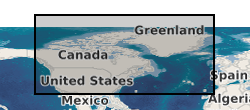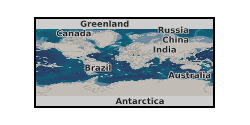Land ice
Type of resources
Topics
Keywords
Contact for the resource
Provided by
Years
Formats
Representation types
Update frequencies
-

Data generated using freely-available satellite remote sensing observations from the USGS Earth Resources Observation Science Centre, together with a freely-available ice margin chronology from Dyke et al. (2003) Geological Survey of Canada Open File Report No. 1574. The map is published in the Journal of Maps: http://www.tandfonline.com/doi/full/10.1080/17445647.2014.912036 Published article in 'Nature' Volume 530 Feb 2016 with associated source data. https://dx.doi.org/10.1038/nature16947 Published paper in the Taylor Francis Online Journal with associated data. https://dx.doi.org/10.1080/17445647.2014.912036
-

There is a report highlighting the approach for model construction and recommendations for any future work. There is an excel file pf processed data including time, centrifuge speed, water pressure, and temperature data. There is a zip folder containing photographs of the models, the instrumentaiton and granular ice used for model construction There is a zip folder containing the raw data.
-

This dataset comprises zircon U-Pb data on 11 samples, each containing ~90-150 individual grains. This method was applied to sediment samples from IODP Expedition 374 Site U1521 to the Ross Sea, collected on the RV JOIDES Resolution. Shipboard biostratigraphy and magnetostratigraphy suggests the samples are mainly early Miocene in age (McKay et al., 2019). The uppermost samples do, however, include younger Plio-Pleistocene sediments. Samples were measured using an Agilent 7900 laser ablation inductively-coupled plasma mass spectrometer (LA-ICP-MS) with a 25-35 µm pit diameter in the London Geochronology Centre at University College London.
-

2014 and 2016 time series of basal multiprobe data (Dataset 1), englacial temperature data (Dataset 2), and englacial tilt data (Dataset 3) measured in boreholes drilled at the location of the SAFIRE research project, Store Glacier, Greenland.
-

This dataset comprises neodymium (Nd) and strontium (Sr) isotope compositions measured on 72 sediment samples, from IODP Expedition 374 Site U1521 to the Ross Sea. These were collected on the RV JOIDES Resolution. Shipboard biostratigraphy and magnetostratigraphy suggests the samples are mainly early Miocene in age (McKay et al., 2019). The uppermost samples do, however, include younger Plio-Pleistocene sediments. Neodymium and Sr isotope analyses were conducted using a multi-collector inductively coupled plasma mass spectrometer (MC-ICP-MS) and a thermal ionisation mass spectrometer (TIMS), respectively, in the MAGIC laboratories at Imperial College London. Neodymium and Sr isotopes in sediments can be compared to measurements from terrestrial rock samples, allowing the changing provenance of the sediments to be traced. This dataset therefore provides information on how erosion by Antarctica’s ice sheets bordering the Ross Sea has changed over time. Neodymium isotopes are reported in the epsilon notation, which denotes the deviation in parts per 10,000 from the present-day composition of the Chondritic Uniform Reservoir (143Nd/144Nd = 0.512638) (Jacobsen and Wasserburg, 1980).
-

Antarctica and its ice sheets have played, and continue to play, a major role in the global ocean-atmosphere system, hence, it is critical that we have a sound understanding of the past behaviour of Antarctica and it's ice sheets with a view to understanding their potential future variability under a warming climate. The Southern Ocean is a key component of the thermohaline circulation of the world's oceans and the re-distribution of heat and salt around the oceans is integral to processes that regulate rapid climate transitions. Computer modelling results have shown that sufficient melt water input to the Antarctic continental shelf area is capable of shutting down the formation of cold, salty deep water in Antarctica hence upsetting the balance of the thermohaline circulation and the ocean-climate system of the Northern Hemisphere. In order to further investigate these processes that originate in Antarctica, it is necessary to understand the transfer mechanisms of ocean-climate signals from the Antarctic ice sheets, across the continental margin seas, into the Southern Ocean. Exceptionally well-preserved Antarctic margin sediment cores, recovered during the last decade, contain an excellent archive of these ice-ocean-climate interactions, often on seasonal timescales, from the end of the last ice age and throughout the recent warm interglacial (the Holocene). The cores are seasonally layered through the deglaication, intermittently layered through the Holocene, and the layers are dominated by fossil planktonic diatoms (algae); individual species of which are sensitive to sea surface conditions including sea ice concentration, fresh water influx, and open ocean influence upon the margin. Following the last ice age, these Holocene Antarctic sediments record climate fluctuations of tens to thousands of years long and whatever environmental forcing mechanism is responsible for these fluctuations, the changes are likely to be felt in the Antarctic coastal regions first, and the cores proposed for this research are located in prime positions to record these changes. Diatom oxygen isotope measurements represent an under-utilised technique that provides a means of obtaining oxygen isotope records in high latitude environments. The measurement of oxygen isotopes in diatoms is a widely used proxy in the study of the history of lakes, however, to date there have been many fewer attempts to use records of diatom oxygen isotopes in the oceans. Studies that have taken place have demonstrated the sensitivity of diatom oxyegn isotope measurements in polar and sub-polar waters to changes in surface ocean environmental parameters such as salinity, freshwater input and sea surface temperature. The research proposed here will be the first attempt to produce diatom oxygen isotope records from the Antarctic margin, a region sensitive to the waxing and waning of the Antarctic ice sheets in terms of melt water through-put to the Southern Ocean. We propose to investigate the evolution of seasonality along the Antarctic margin since the last ice age, and also the processes involved in producing the sediment record, by relating diatom oxygen isotope measurements on season-specific diatom taxa (i.e. diatom species that thrived particularly in spring or autumn) to relative freshwater influx to the coast, from either melted terrestrial ice or sea ice. We also hope to show that the diatom oxygen isotope measurements will be low at the end of the last ice age, as a large quantity of old ice sheets were melting, and will be higher during warmer time periods of the Holocene when ice sheets were at a minimum.
-

This dataset includes the (stable) oxygen and carbon isotopic composition of benthic foraminifer tests (n= 686) and the (radiogenic) isotopic composition of the terrigenous fraction of marine sediments (n= 75), all sampled from Eocene to Oligocene-aged sediments recovered at Ocean Drilling Program (ODP) Site 689 and 690 (Maud Rise, Southern Ocean)
 NERC Data Catalogue Service
NERC Data Catalogue Service